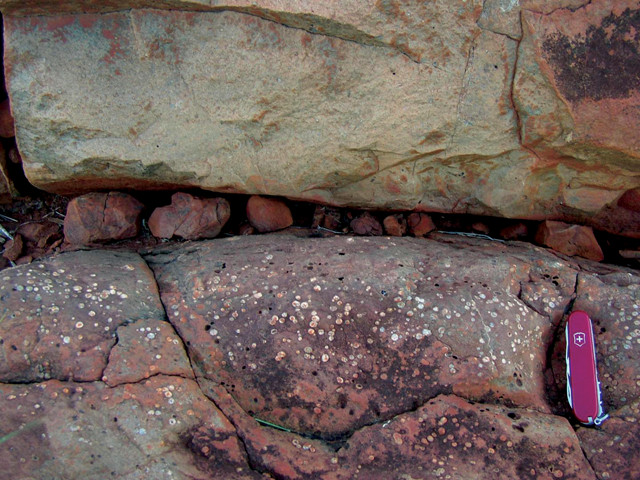
by Mary Caperton Morton Tuesday, September 13, 2016

Researchers analyzed lava flows on the banks of Australia's Beasley River. Gas bubbles that formed as the lava cooled, 2.7 billion years ago, have since filled with calcite and other minerals and appear as white spots. Credit: Sanjoy Som/University of Washington.
The conditions that prevailed on early Earth are, in many ways, as alien as those found on far off exoplanets. Some clues can be found in ancient rocks, but our understanding of the first few billion years of our planet’s history remains hazy. In a new study, a team reports evidence in 2.7-billion-year-old basalt that young Earth’s atmosphere was just half as heavy as today, an insight that may shed light on how marginal conditions found on exoplanets could still support life.
“If we were standing on early Earth, we would struggle to recognize it. We would also die within seconds,” says Sanjoy Som, an astrobiologist at the Blue Marble Space Institute of Science and NASA Ames Research Center in California, and lead author of the new study, published in Nature Geoscience. “There were no animals, no grass, no trees, the moon was a lot closer, tides were stronger, the planet was spinning faster, the sun was fainter, the atmosphere did not have any oxygen, and yet [Earth] was still a habitable planet for our distant microbial ancestors,” says Som, who was a graduate student at the University of Washington when the study was conducted.
During Earth’s first few billion years, the sun’s output was only 70 percent as intense as it is today, meaning temperatures would not have been warm enough to maintain liquid water on Earth if other conditions were similar to today. And yet, geologic evidence of liquid water has been found in abundance. Geologists refer to this discrepancy as the “faint young sun paradox” and usually invoke higher concentrations of greenhouse gases to explain how Earth could have been warm enough for rivers, oceans and rain to exist. These high concentrations of gases should have produced a thicker, heavier atmosphere than we have today, but Som’s team’s research suggests otherwise.
To study the atmospheric pressure of early Earth, Som and his colleagues turned to a proven method used to study paleoelevation: As a lava flow cools from the topsurface down and from the bottom up, the size distribution of bubbles trapped in the solidifying molten rock reflects the weight of the air pushing down on the top of the lava relative to the air pressure and the weight of lava at the bottom of the flow. By assuming the current standard atmospheric pressure of 1 bar at sea level, volcanologist Dork Sahagian of Lehigh University in Bethlehem, Pa., has tested this method to deduce eruption elevations of recent flows in Hawaii, and has also used it to determine paleoelevations of flows on the Colorado Plateau and in the highlands of Mongolia.
Som and his colleagues flipped this method, instead using a known paleoelevation of zero (at sea level) to calculate the density of the ancient atmosphere. “About 20 years ago, I suggested using this method on basalts erupted at sea level to calculate air pressure, and I’ve been waiting for somebody to get around to doing it,” says Sahagian, who was not involved in the new study. “This study boldly goes where nobody has gone before.”
Finding basalt dating back to the Early Archean with telltale signs that it erupted at sea level is difficult, but Som’s co-authors, Tim Blake of the University of Western Australia in Perth and Roger Buick of the University of Washington, found such a flow in Western Australia. Amid the Pilbara Craton, the Beasley River has exposed a 2.7-billion-year-old basalt flow with distinctive toes composed of glassy lava shards, where the flow was rapidly cooled when it plunged into seawater. By coring the top and bottom of the flow and measuring the bubbles trapped within the rocks, the team showed that the air pressure at the time of the flow was about half what it is today.
The findings match up with those in a 2012 study published in Nature in which Som studied fossilized imprints left by ancient raindrops; that work suggested, for the first time, that air was thinner, not thicker on early Earth, Som says.
The implications of a lighter atmosphere are broad and not yet fully understood, Som says, “but it could affect everything from climate to biological evolution.” A half bar of pressure is roughly equivalent to the pressure atop Mont Blanc in the French Alps, he says. “So it’s not unimaginable. It also shows that you don’t need 1 bar of pressure to sustain life. That gives us something to think about when we’re looking for potentially habitable exoplanets.”
The next step is to sample more lava flows, Sahagian says. “I’d love to see them go around the world, look for basalts erupted at sea level over time and make a curve of atmospheric pressure throughout geologic time. That would be a really fantastic application for this method.”
© 2008-2021. All rights reserved. Any copying, redistribution or retransmission of any of the contents of this service without the expressed written permission of the American Geosciences Institute is expressly prohibited. Click here for all copyright requests.